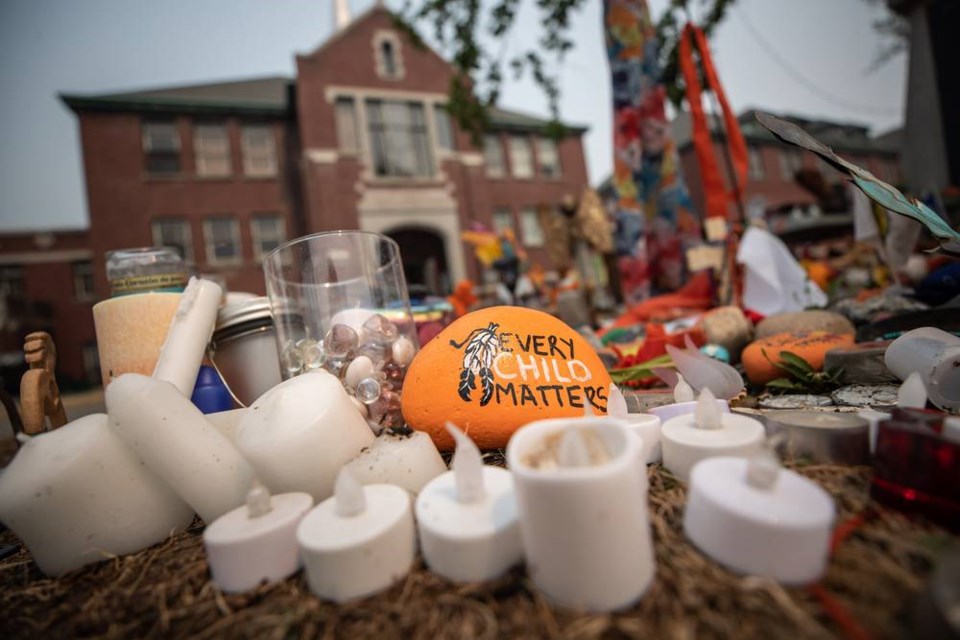The B.C. government says it will provide immediate funding to First Nation communities to help with searches for human remains at 21 former residential schools or hospitals, including six sites on Vancouver Island and smaller islands nearby.
Communities can receive up to $475,000 for each site as they carry out searches, planning, technical work and archival research, while also engaging with elders, survivors and other First Nations that have an interest in an area, said Murray Rankin, minister of Indigenous relations and reconciliation.
No deadline is attached to the grants, he said. The funding is from the $12 million the province announced last month for research at former residential school sites, as well as for mental-health and cultural supports for Indigenous communities.
Five residential schools operated on or just off the coast of the Island, along with a hospital in Nanaimo.
William Yoachim, a Snuneymuxw First Nation councillor, said Tuesday’s announcement is a good starting point, because it means the subject is receiving attention, and many people are not aware of what happened at the Indian hospitals.
The institutions operated as racially segregated hospitals, although the original justification for them was to isolate tuberculosis, according to the Canadian Encyclopedia.
The hospitals were understaffed and underfunded, which resulted in poor living conditions for patients, who were often forced to spend years in the institutions because it was a crime for Indigenous people to refuse to go to a hospital or leave before being discharged.
While medical treatment for tuberculosis improved in the 1940s and 1950s, Indigenous patients were subjected to outdated treatment, and in some cases medical experimentation. Survivors have recounted physical and sexual abuse.
“When everything is said and done, the mainstream population is going to see similarities between residential schools and the Indian hospitals,” said Yoachim, whose late mother was in an institution.
The First Nation will likely apply for funding to search for remains near the former hospital, which operated from 1946 to 1967, as soon as possible, he said.
Ahousaht First Nation is applying for up to $950,000 to search two sites at the Ahousaht Residential School and the Christie Residential School, said Chief Greg Louie.
Louie said while it’s important to get the work started, it’s also bittersweet. “It’s really, really sad and unfortunate that we have to do this work. It should have never, ever happened.”
Louie said he’s unsure if the funding will be enough to complete the work, but it will help to get things started.
Ahousaht recently received $75,000 through a fundraising campaign to search former residential school sites.
The government announced the appointment of Charlene Belleau and Lydia Hwitsum, a former chief of Cowichan Tribes, as First Nations liaisons to help the communities as the search for remains continues. Hwitsum was the Green Party candidate in Cowichan-Malahat-Langford in the 2019 federal election.
Belleau, 68, said she would like to find the remains of her great-grandfather, who took his own life while at St. Joseph’s Mission Residential School in Williams Lake.
The former chief of Esk’etemc First Nation said finding the remains of Augustine Allen will bring closure for her.
“They buried him there without telling our family,” she told a news conference.
“This was during a period of time when flogging was at its worst. They strung our children on poles and lashed them until they passed out.”
The Tk’emlups te Secwepemc Nation announced in May that ground-penetrating radar had identified what are believed to be the unmarked graves of about 200 children at the former Kamloops Indian Residential School. Several other First Nations have announced similar findings since then.
The final report of the Truth and Reconciliation Commission identified about 6,000 missing children, but anticipated the actual number was higher.
Belleau said an eight-year-old, Duncan Sticks, ran away from St. Joseph’s and froze to death. An inquest was held into his death with no results and no change for the residential school for years, she said.
These stories come from her own experience and from research she undertook to understand what Indigenous communities faced, she said.
Belleau found out about her great-grandfather, who died in the summer of 1920 by eating poisonous water hemlock, through a report she oversaw years later, she said. That’s when she asked her mother about it.
“She just said ‘Yes, that happened,’ but didn’t really want to talk about it,” Belleau said in an interview.
“I think we have to respect that our elders or our parents may be strong Catholics, and I don’t want to insult or hurt her, either. So, I just took it that she never said anything, but it was there in black and white for me to see.”
“We’ve waited for this time for a long time. Through all of those inquiries we told governments, we told churches, our children never came home,” Belleau said at the news conference. “They never believed us. Now we know. Now you know. We have a responsibility to work together to bring our loved ones home.”
> The Indian Residential Schools Resolution Health Support Program has a hotline to help residential school survivors and their relatives suffering with trauma invoked by the recall of past abuse. The number is 1-866-925-4419.



